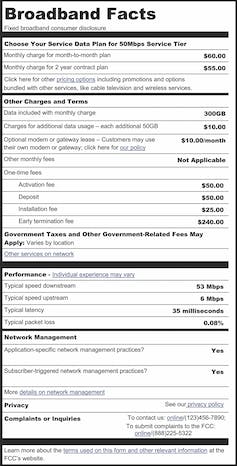Imagine purchasing “up to” a gallon of milk for US$4.50, or paying for “up to” a full tank of gas. Most people would view such transactions as absurd. And yet, in the realm of broadband service, the use of “up to” speeds has become standard business practice.
Unlike other advertisements for goods and services – for example, what a car manufacturer tells a customer about expected fuel efficiency – there are no federally set standards for measuring broadband service speeds. This means there is no clear way to tell whether customers are getting what they pay for.
Consumers typically purchase an internet service package that promises a speed up to some level – for example, 10 megabits per second, 25Mbps, 100Mbps, 200Mbps or 1000Mbps/1Gbps. But the speed you actually receive can often be much less than the advertised speed. Unlike the vehicle sector’s fuel efficiency standards, there’s no government mandate to systematically improve internet service speeds – and no national strategy for ensuring that slow connections are upgraded in a timely fashion.
A home user’s quality of service can also shift dramatically over relatively short periods of time and can become especially degraded during times of crisis. For example, during the early months of the COVID-19 pandemic when millions of Americans switched from using their office’s business-class internet connection to teleworking from home using their residential internet service, analysis showed widespread slowdowns in service speeds.
Follow-up research found that during this same time frame, the Federal Communications Commission was inundated with consumer complaints from across the country. Complaints about billing, availability and speed increased from February 2020 to April 2020 by 24%, 85% and 176%, respectively. So even though monthly bills did not change, customers experienced worse service, with lower speeds and less reliability.
The discrepancy between advertised and actual speeds also varies by geographic location. Rural areas consistently see larger discrepancies than urban areas. Broadband service descriptions are often confusing because many plans that consumers think are unlimited actually have data caps. These plans often limit data usage by slowing or “throttling” connections after users hit their caps.
Minimums and measurements

The FCC is taking comments for a proposed ‘broadband nutrition label’ to help consumers understand what they’re paying for, but the devil is in the details.
Federal Communications Commission
Consumer advocates have long called for a “broadband nutrition label” that would create a federal mandate for internet service providers (ISPs) to disclose speed, latency (for example, the level of delay in videoconferencing calls), reliability and pricing to potential and current consumers. The FCC is seeking comment on proposed broadband nutrition labels, and there is a risk…


